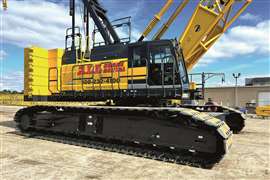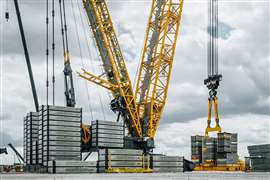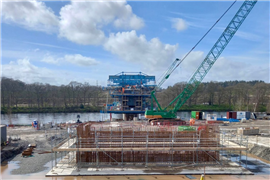Link-Belt RT at work on Virginia interstate
03 August 2020
A new 120-ton Link-Belt 120|RT rough terrain crane is at work for Corman Kokosing Construction of Annapolis Junction, MD for a $35 million improvement project at the interchange of Interstate 64 and Airport Drive near Richmond, VA. The project includes removing two on-ramps of a cloverleaf interchange in order to add better access and egress to Interstate 64 from Airport Drive, add an additional traffic lane in each direction, and add clearance height for freight traffic.

Operator Gerald Cubbage does not have much room to maneuver the 50-foot long sheets, placing sheet pile at up to a 60-foot radius.
The 120|RT is driving 50-foot long PZ-27 steel sheets and 14-inch H-pile for construction of new overpass bridges.
A rigged vibratory hammer weighs 6,000 pounds and is equipped with vibratory dampeners (for minimizing vibration to the boom) to drive steel sheeting which weighs roughly 100 pounds per foot. Corman Kokosing has made it a policy to use only 75 percent of chart capacity in the crane’s operations, so operator Gerald Cubbage uses the 120-ton’s four different crane boom modes to make sure all maneuvers are safe.
The working area for the 120|RT is limited to the median between two existing bridges of Interstate 64. Operator Gerald Cubbage does not have much room to maneuver the 50-foot long sheets, placing sheet pile at up to a 60-footradius.
“When you thread sheets into each other, you barely touch the crane lever, and then you speed up with it to get the sheet down once it’s threaded,” said Cubbage. ”Then I scope my boom in to get the large vibratory hammer that is stored next to the westbound bridge. I scope my boom out while lifting the hammer to the sheet ready to be vibrated into the ground.”

The working area for the 120|RT is limited to the median between two existing bridges of Interstate 64.
To drive H-pile Cubbage hoists a 120-foot long lead and a diesel hammer weighing 28,000 pounds combined, working at a 36-foot radius and 66 degree boom angle when driving pile. Ten plum H-pile are required at the abutments and 18 H-pile in the median for Phase 1, set 54 inches apart.
“It takes experience, along with a good eye to thread the sheeting or place the vibratory hammer clamps onto the upstanding sheets,” he added. ”It also helps when you have a smooth machine. You have to be careful as to what you are doing, especially when changing boom lengths frequently with a load in this area.”
Corman Kokosing Construction crews have been working demolition at night as well as driving sheeting and H-pile during the day. The project began in November of 2018, with completion of all three phases scheduled for late 2022.
STAY CONNECTED


Receive the information you need when you need it through our world-leading magazines, newsletters and daily briefings.








